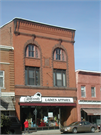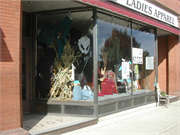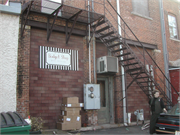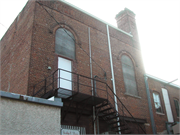Property Record
133 W MAPLE ST
Architecture and History Inventory
| Historic Name: | IOOF HALL |
|---|---|
| Other Name: | MACANDIS LADIES APPAREL |
| Contributing: | Yes |
| Reference Number: | 45329 |
| Location (Address): | 133 W MAPLE ST |
|---|---|
| County: | Grant |
| City: | Lancaster |
| Township/Village: | |
| Unincorporated Community: | |
| Town: | |
| Range: | |
| Direction: | |
| Section: | |
| Quarter Section: | |
| Quarter/Quarter Section: |
| Year Built: | 1901 |
|---|---|
| Additions: | |
| Survey Date: | 2005 |
| Historic Use: | social recreational/fraternal hall |
| Architectural Style: | Romanesque Revival |
| Structural System: | |
| Wall Material: | Brick |
| Architect: | |
| Other Buildings On Site: | |
| Demolished?: | No |
| Demolished Date: |
| National/State Register Listing Name: | Courthouse Square Historic District |
|---|---|
| National Register Listing Date: | 4/7/2006 |
| State Register Listing Date: | 1/20/2006 |
| National Register Multiple Property Name: |
| Additional Information: | TWO STORY ROUND ARCH OPENINGS, A RUSTICATED STONE TRIM, AN EGG AND DART MOLDING AND A BRICK CORBEL TABLE AT THE CORNICE LINE ARE DISTINCTIVE FEATURES OF THE IOOF BUILDING. BECAUSE OF THE ARCHITECTURAL DETAILINGS, THE INTENSIVE SURVEY LISTED THE BUILDING'S STYLE AS RICHARDSONIAN ROMANESQUE. THE SURVEY EVALUATION CRITERIA USED WAS ARCHITECTURE/ENGINEERING DATA. OTHER CHARACTERISTICS OF THIS THREE STORY STRUCTURE ARE A RECTANGULAR PLAN CONFIGURATION, A FLAT ROOF AND A BRICK EXTERIOR. THE BUILDING WAS FOUND TO BE IN EXCELLENT CONDITION. THE HISTORIC USES OF THIS STRUCTURE INCLUDED THE IOOF LODGE WHICH WAS HOUSED THERE FROM 1901 TO C.1927 (B), AND A CLOTHING STORE WHICH WAS A TENNANT FROM 1901 TO AT LEAST 1927 (B). ARCHTECTURAL STATEMENT: A STRIKING FEATURE OF LANCASTER'S COMMERCIAL DISTRICT, THE IOOF BUILDING IS AN IMPORTANT ILLUSTRATION OF RICHARDSONIAN ROMANESQUE-INSPIRED COMMERCIAL ARCHITECTURE. THE EARLY TWENTIETH CENTURY STRUCTURE, WHICH IS CHARACTERIZED BY TWO-STORY ROUND ARCH OPENINGS THAT ARE OUTLINED BY ROUGH CUT STONE, REFLECTS CHANGING ARCHITECURAL TASTES AND THE CITY'S CONTINUING COMMERCIAL AND SOCIAL GROWTH. HISTORICAL BACKGROUND: THE MISSISSIPPI VALLEY LODGE, NO. 86, OF THE INDEPENDENT ORDER OF ODD FELLOWS (IOOF) WAS ORGANIZED IN LANCASTER IN NOVEMBER 1855. (THE YEAR 1856 IS SHOWN ON THE BUILDING'S NAME AND DATE PLAQUE. PERHAPS THE LODGE WAS OFFICIALLY RECOGNIZED IN THAT YEAR). IN 1869, GERMAN-BORN MEMBERS OF THE LODGE TOOK STEPS TO ESTABLISH A GERMAN LODGE, THE HOFFMING (HOPE) LODGE, NO. 172, WHICH WAS SANCTIONED BY THE GRAND LODGE OF WISCONSIN IN THE SAME YEAR. (C). THE LODGES HELD THEIR MEETINGS IN A NUMBER OF LOCATIONS BEFORE CONSTRUCTING THIS DISTINCTIVE THREE-STORY BUILDING IN 1901. IN ADDITION TO ACCOMMODATING LODGE ACTIVITIES, THE IOOF BUILDING HOUSED A RETAIL STORE ON THE GROUND LEVEL. (B) 2005- When the Independent Order of Odd Fellows built themselves a new lodge hall in 1901, they also built one of the district's most architecturally distinctive buildings and one whose exterior is almost totally intact today. The I.O.O. F. building is rectilinear in plan and three-stories-tall and its main facade faces south onto W. Maple St. and is faced with brick. This symmetrically designed facade features a intact first story storefront that consists of two centered display windows that are flanked on either side by inset entrances that feature paired entrance doors to the store on the right-hand side and to the second story on the left. The upper stories are two-bays-wide and each bay is two-stories-tall and is inset slightly into the facade. These bays both have semi-circular-arched heads and they feature a triple window group in each of their two stories. These groups are separated from one another by a paneled brick spandrel that is positioned between them within the bay. The edges of these bays are trimmed with small sandstone blocks that have a quarried surface, and a dressed sandstone keystone of somewhat exaggerated proportions is centered in the arched head of each bay and forms part of the stringcourse above that serves as the base for the tall corbelled brick cornice that crowns the facade. (See Photo No. 2) The design of this building is a sophisticated one that is almost certainly the product of a still unknown architect. Whoever designed it was aware of trends then prevailing in architectural styles, but combined them in a fashion that could only have occurred at the end of the Late Victorian era. Thus, the use of semi-circular-arched window heads and the trimming of the upper story's bays with rock-faced sandstone that contrasts with the otherwise smooth brick surface of the facade are both features that are sometimes associated with the Richardsonian Romanesque Revival style, but the placement of these bays within recessed and arched two-story bays and the use of various classically derived elements such as keystones can also be found on Beaux-Arts Classical style buildings of the same period. |
|---|---|
| Bibliographic References: | A. ON BUILDING. B. 1905, 1912, 1927 SANBORN PERRIS MAP. C. HISTORY OF GRANT COUNTY, WISCONSIN, (CHIGAGO: WESTERN HISTORICAL CO., 1881), P. 671. D. CITY OF LANCASTER TAX ROLLS. 2005, Tim Heggland. National Register of Historic Places Registration Form, Courthouse Square Historic District. |
| Wisconsin Architecture and History Inventory, State Historic Preservation Office, Wisconsin Historical Society, Madison, Wisconsin |





